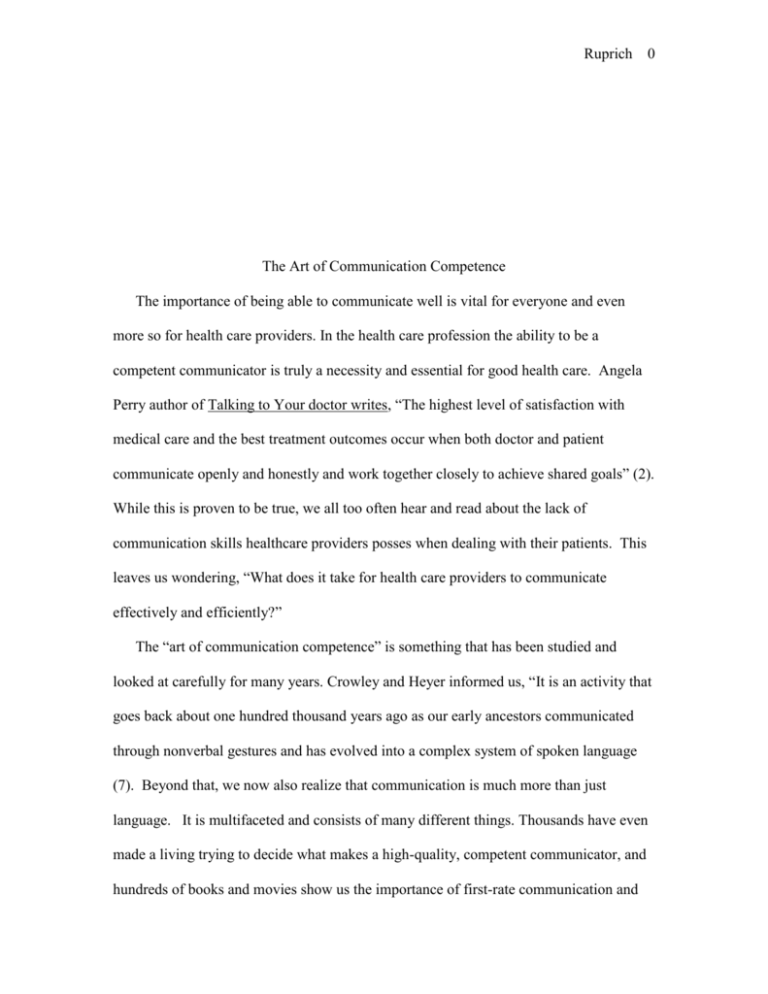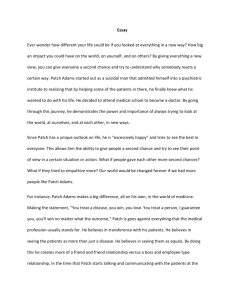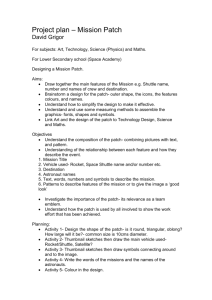The Art of Communication Competence
advertisement

Ruprich 0 The Art of Communication Competence The importance of being able to communicate well is vital for everyone and even more so for health care providers. In the health care profession the ability to be a competent communicator is truly a necessity and essential for good health care. Angela Perry author of Talking to Your doctor writes, “The highest level of satisfaction with medical care and the best treatment outcomes occur when both doctor and patient communicate openly and honestly and work together closely to achieve shared goals” (2). While this is proven to be true, we all too often hear and read about the lack of communication skills healthcare providers posses when dealing with their patients. This leaves us wondering, “What does it take for health care providers to communicate effectively and efficiently?” The “art of communication competence” is something that has been studied and looked at carefully for many years. Crowley and Heyer informed us, “It is an activity that goes back about one hundred thousand years ago as our early ancestors communicated through nonverbal gestures and has evolved into a complex system of spoken language (7). Beyond that, we now also realize that communication is much more than just language. It is multifaceted and consists of many different things. Thousands have even made a living trying to decide what makes a high-quality, competent communicator, and hundreds of books and movies show us the importance of first-rate communication and Ruprich 1 ways in which it can best be obtained. A well known movie that looks at the importance of competent communication in both health care and life is called “Patch Adams”. It takes a deep look at the magnitude of and different styles of communication frequently seen in the healthcare system. While viewing this movie and watching the relationships Robin Williams has with his patients, one can definitely see the significant role that competent communication has on a person’s social needs, identity needs, practical needs, and most of all, a person’s physical needs. The film leaves the viewer asking the same questions analysts all over the world ask, “How can we become a nation that realizes the importance of communication and all become competent communicators?” The answer may not come easy for everyone, but the communication style and relationships that the doctor shares with his patients in this movie reminds us that communication competence is achievable. All too often when people hear the words communicate, they think we are talking about language. While language is definitely an important part of communication, it is only a small piece of the whole puzzle. The text by Adler, Rosenfeld, and Proctor, reminds us that “Human communication is a complex process with many components (7). Even when we take a close look at language alone, we can see the many different aspects it is composed of and its importance. Despite the fact that it is not the only contributor to communication competence, it is a big one and throughout the movie, Patch Adams, you can’t help but notice the way in which Robyn Williams uses language to connect with his patients. In order to bridge the gap that often lies between patient and doctor, Patch uses language carefully, using “I” language in order to clarify messages, avoiding ambiguous Ruprich 2 language and dialectical tensions, and by using simple techniques like convergence in order to deeply connect and identify with others. For example, in the middle of the movie he meets a patient that is dying and lashes out furiously at Patch. Patch shows his ability to communicate well by staying calm and showing that it is important to,” Speak with honor and personal integrity even when the other person behaves badly” (Lerner 17). By giving an empathetic response he enables the patient to feel important, cared about, and understood; a concept often forgotten by physicians who tend to use divergence to separate themselves from their patients. This form of disconfirming communication leads the patient to feel as if they are not of value, and this may be one of the reasons why we frequently hear things like that doctor is very “business like”. Williams showed us that using language that puts you on the same level as your patient, and does not make the individual think you feel you are above or superior to them, definitely allows for better communication. It is without a doubt that language can reflect a person’s interest and sincerity towards another person. In the book Conversationally Speaking writer Alan Garner puts it simply like this, “The interest you show will frequently lead people to expand upon comments. The fact that you aren’t critical of their thoughts and feelings will help them to feel comfortable and to self-disclose more and in greater depth than they other wise might” (45). Another attribute that Patch possessed that allowed him to be a competent communicator was the ability to truly listen to others. This is not as simple as one might think. Michael Nichols stated it just right when he wrote, “Listening is so basic we take it for granted. Unfortunately most of us think of ourselves as better listeners than we really are” (11). In the movie we saw numerous doctors that never really listened to their Ruprich 3 patients. On the other hand, Patch Adams full heartedly listened to each and every one of his patients. He was never a stage hog, an ambusher, or a selective listener. He had every characteristic that a “true listener” possesses and authors Adler, Rosenfeld, and Proctor remind us of what that is when they wrote, “In truth, listening- especially mindful listening- consists of five separate elements: hearing, attending, understanding, remembering, and responding” (181). Patch had all five elements. Another author, Michael P. Nichols, wrote an explanation of a competent listener that I think really describes Patch as well as any skilled listeners, “Genuine listening means suspending memory, desire, and judgment- and for a few moments at least, existing for the other person” (64). Looking at the wonderful examples of true listening Patch Adams demonstrated to viewers and thinking about what makes a truly competent listener should make us all realize that this is one area that we can all improve in since, “effective communication isn’t achieved simply by taking turns talking; it requires a concerted effort at mutual understanding” (Nichols 114). Patch Adams (Robyn Williams) had another quality that I noticed right away that made him the competent communicator he was, and that was the ability to use a multitude of positive nonverbal communication behaviors and skills in order to communicate well. One that caught my attention immediately was what scientists have studied for years and call hepatics or the study of touch. “Often touching expresses sentiments that words alone can’t convey at all” (Garner 146). Touch gives an unspoken message of warmth and liking and touch is really a remarkable thing when used at the right times and for the right reasons. When thinking about the importance of touch, I can’t help but remember when my sister gave birth to her twins over two months early. Ruprich 4 The hospital staff constantly encouraged her to touch and talk to them because it has been proven that premature babies that are touched a lot, especially by their mother, have a better chance for survival. Furthermore, The University of Texas M.D. Anderson Cancer Center reports the following to be true in regards to touch, “We also know it simulates the immune system, gastrointestinal tract, and improves circulation. Studies have shown that light gentle massage can help reduce nausea, pain, diarrhea, and other side effects of cancer.” Yes, to sum it up is easy; the power of touch is simply extraordinary and a great instrument in communication competence. The other nonverbal communication skill I noticed that played a large part in Patch’s communication competence was the way he kept eye contact with the individuals he was communicating with. Keeping good eye contact conveys a very important message to others. Eye contact shows a person that you are interested in them and what they are saying. “It says to your conversational partners, “I’m more interested in you right now than I am in anything else” (Garner 147). It can make someone feel important and powerful. The opposite effect happens when you avoid eye contact with someone. A person may then feel they are being rejected, are unimportant, or that you are dishonest, non-caring, or anxious. Author Kendra Van Wagner reminds us that “Looking at another person can indicate a range of emotions, including hostility, interest, and attraction”. With that said, it is easy to see the importance of eye contact. Now, I will mention the one nonverbal communication skill that I, and most people, feel is extremely important in effective communication; a smile. Patch Adams did this constantly. He combined it with laughter in order to get people to relax and feel that he cared. He understood that a smile allows people to feel comfortable and self-disclose Ruprich 5 when they may not otherwise. This type of action also has a way of starting a positive communication pattern and preventing defensiveness and other negative communication problems that frequently occur. When we don’t smile we tend to look unfriendly, unreceptive, unresponsive and all together unapproachable. Remember the saying, “A smile is contagious”, it is true. All around the world people smile to send positive messages to others. Adler, Rosenfeld, and Proctor report, “Smiles and laughter are a universal signal of positive emotions, for example, while the same sour expressions convey displeasure in every culture” (152). Plus, we should all remember it’s easier anyway. Garner reminds us of that by pointing out , “It takes seventy-two muscles to frown, but only twenty-three to smile - and smiling has much more pleasurable results” (149). Patch Adams and all great communicators understand that and know that a smile is truly a universal language and should be done regularly. Focusing on the communication skills Patch Adams possessed when communicating with him patients truly summed up what it takes to be a competent communicator. He practiced active listening and avoided communication tensions by truly caring and practicing positive communication skills. He worked hard to achieve deeper levels of understanding communication so he could become the best communicator possible. Ruprich 6 Works Cited Adler, Ronald B., Lawrence B. Rosenfeld, and Russell F. Procter II. Interplay: The Process of Interpersonal Communication. 10th ed. New York: Oxford U P, 2007. Cancer Wise – The Healing Power of Touch. Jan. 2002. The University of Texas M.D. Cancer Center. 3 May. 2007< www.cancerwise.org/january2002/display.cfm?id = 715B2134-2C94-41E9-801166EOO>. Crowley, David, and Paul Heyer. Communication in History Technology, Culture, Society. New York: Longman Group, 1991. Garner, Alan. Conversationally Speaking. 3rd ed. Los Angeles: Lowell House, 1997. Lerner, Harriet. The Dance of Connections. New York: HarperCollins Publishers Inc., 2001. McGinty, Sarah M., Power Talk: Using Language to Build Authority and Influence. New York: Warner Books, 2001. Nichols, Michael P., The Lost Art of Listening. New York: Guilford Press, 1995. Patch Adams. Dir. Tom Shadyac. Perf. Robin Williams and Monica Potter. Universal, 1999. Perry, Angela. Guide to Talking to Your Doctor. New York: John Wiley & Son, 2001. Savan, Leslie. Slam Dunks and No-Brainers. New York: Random House, 2005. Types of Non Verbal Communication. Van Wagner, Kendra. 2007. About Psychology. 5 Ruprich May 2007 http://psychology.about.com/od/nonverbalcommunicaion/a/ nonverbaltypes.htm>. 7




![Pumpkin Patch - L2 exam summary questions[1]](http://s3.studylib.net/store/data/006891404_1-eaba8a01ed43ce8c58f5173adc5f257b-300x300.png)


